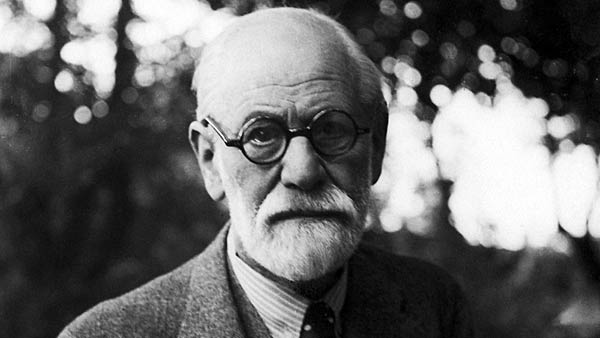Why do people seek ecstasy, those moments of “getting out” of ourselves–getting high? Biochemically, ecstasy can be explained; receptor sites on brain cells connect to natural and man-made substances which reduce pain, and produce sensations and feelings we find pleasurable and relieving. In other words, ecstasy is an emotional experience, and for many, the more powerful that emotional experience, the better.
Happiness itself is often a major fixation; from religion to politics, pursuing happiness preoccupies human culture. Here in the west, the founder of psychoanalysis Sigmund Freud (photo above) proposed The Pleasure Principle as a fundamental force in human psychology, and he rooted it in human sexuality. The drafters of our Declaration of Independence famously highlighted “the pursuit of happiness.” Tibet’s Dalai Lama declares that all people seek happiness. Why is that?
If we accept Freud’s theory, happiness originates in sexuality and the feelings accompanying it. As a primal force in human nature, identifying happiness with sexual feelings certainly explains why its pursuit is so widespread. Yet, Freud was a product of Victorian society, and his focus on the role of sexuality on human psychology is now seen as skewed by his personal cultural experience. French psychoanalyst Jacques Lacan updated Freud beginning in the 1950s, expanding upon Freud’s sex-based Pleasure Principle; he cryptically referred to it as “Jouissance,” an “orgasmic” force, and advocated for its primary role in human behavior. This is not unlike the Chinese Taoist concept of “Chi”, a supremely powerful, energetic life-force, or for that matter, Hindu “Kundalini.” Yet, the theories of sexually-rooted pleasure do not fully explain the pursuit of ecstasy, and may over-simplify an experience associated not just with religion, but also the highest arts of culture.
For some, ecstasy comes through group identification and for others self-expression. Religion–both institutional and tribal–touches upon another very human need, namely social acceptance through group absorption. Every bit as powerful as sexuality, human social needs are primal. No other animal experiences infant dependency and childhood for as long as people do. Accordingly, modern psychology now includes “attachment theory” as one explanation for human behaviors, both healthy and destructive.
The arts–traditionally disciplines of painting, music, writing, dance, theatre, sculpture and architecture, but now expanded into tattooing, crafts, blogging, and clothes made from trash–signify the importance of self-expression as a source of ecstasy. “The Agony and the Ecstasy” is the title of a 1961 book by Irving Stone about Michelangelo (and talk about agony, a movie starring Charlton Heston) and the vision of the lone artist doggedly pursuing creative genius at all costs still resonates.
Popular street drugs like cocaine, meth and heroin all reputedly produce ecstatic highs at the price of soul-crushing addiction, testimonial to the powerful lure of escaping ourselves and the pressures of reality. Speaking of escape, the Ford Motor Company hopes the thought of sitting in their luxurious Lincoln MKZ will feel ecstatic, and spends many millions on advertising to accomplish that. So too all advertising–cars, beer, burgers, air-fresheners–sells happiness and ecstasy.
Based on what we observe, people are terribly unhappy. Though the Dalai Lama does not say it very much, human suffering may be more powerful than happiness, which is to say all beings seek happiness because they suffer. Naturally, this brings up another round of questions: why do we suffer and is suffering at the root of ecstasy?








There are many paths to ecstasy! They have to do with achieving a goal above and beyond the norm. I always felt ecstatic when achieving a sale which at first blush seemed impossible. Beating out the perceived dominant player.